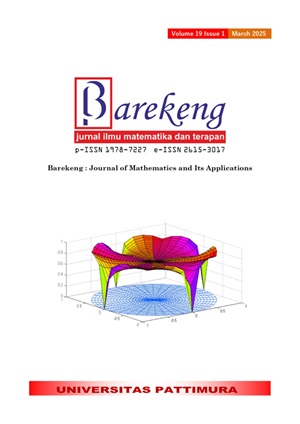COMPARATIVE ANALYSIS OF TWO-STEP AND QUASI MAXIMUM LIKELIHOOD ESTIMATION IN THE DYNAMIC FACTOR MODEL FOR NOWCASTING GDP GROWTH IN INDONESIA
Abstract
Economic activity data is needed quickly to make policy decisions, but this data suffers from publication delays. Gross Domestic Product (GDP) data is released within five weeks after the end of the quarter. An effort that can be made to provide such data is through nowcasting, which is forecasting in the current period using variables that have a higher frequency. This study aims at nowcasting GDP growth. The nowcasting method used is the Dynamic Factor Model (DFM) with Two Step (TS) and Quasi Maximum Likelihood (QML) estimation. The nowcasting results show that the DFM-TS model is better than the DFM-QML because it has a larger adjusted R-squared value and has the smallest RMSE value of 1.71035 compared to the DFM-QML value, which has an RMSE value of 1.71598.
Downloads
References
I. Hendarsih, “Implementasi Multiplier Pajak Terhadap Produk Domestik Bruto (PDB) Di Indonesia Tahun 2010 sd 2022,” Monet. Akunt. dan Keuang., vol. 10, no. 1, pp. 95–99, 2023.
D. Silitonga, “Pengaruh Inflasi Terhadap Produk Domestik Bruto (Pdb) Indonesia Pada Periode Tahun 2010-2020,” ESENSI J. Manaj. Bisnis, vol. 24, no. 1, p. 2021, 2021.
S. Ma’Arif, “Nowcasting Pertumbuhan Produk Domestik Bruto Indonesia Menggunakan Dynamic Factor Model,” Institut Teknologi Sepuluh Nopember, 2019.
J. N. B. S. Ringo and A. K. Monika, “Aplikasi Dynamic Factor Model untuk Nowcasting Pertumbuhan Ekonomi Regional Menggunakan Data Google Trends di Indonesia,” in Seminar Nasional Official Statistics, 2021, pp. 157–165.
K. Tanuwidjaja, A. Widjaja, and others, “Prediksi dan Analisis Time Series pada Data Covid-19,” J. Strateg. Maranatha, vol. 4, no. 1, pp. 144–158, 2022.
P. K. Supriyatna, “Penerapan Dynamic Factor Model Pada Nowcasting Pertumbuhan Ekonomi Sektoral Dengan Data Berfrekuensi Tinggi,” Institut Teknologi Sepuluh Nopember, 2023.
M. J.-F. Dauphin et al., Nowcasting gdp-a scalable approach using dfm, machine learning and novel data, applied to european economies. International Monetary Fund, 2022.
B. P. statistik Stat, “Statistik Indonesia,” Jakarta, 2023.
J. Geweke, “The dynamic factor analysis of economic time series,” Latent Var. socio-economic Model., 1977.
T. J. Sargent, “Business Cycle Modeling without Pretending to Have Too Much A-priori Economic Theory,” 1977.
C. Doz, D. Giannone, and L. Reichlin, “A quasi--maximum likelihood approach for large, approximate dynamic factor models,” Rev. Econ. Stat., vol. 94, no. 4, pp. 1014–1024, 2012.
C. Doz, D. Giannone, and L. Reichlin, “A two-step estimator for large approximate dynamic factor models based on Kalman filtering,” J. Econom., vol. 164, no. 1, pp. 188–205, 2011.
J. Tian, J. Liu, D. Elsworth, and Y.-K. Leong, “A 3D hybrid DFPM-DFM Model for gas production from fractured shale reservoirs,” Comput. Geotech., vol. 159, p. 105450, 2023.
J. Bai and S. Ng, “Determining the number of factors in approximate factor models,” Econometrica, vol. 70, no. 1, pp. 191–221, 2002.
L. Mosley, T.-S. Chan, and A. Gibberd, “sparseDFM: An R Package to Estimate Dynamic Factor Models with Sparse Loadings,” arXiv Prepr. arXiv2303.14125, 2023.
Copyright (c) 2025 Gilbert Alvaro Souisa, Reyner M. Leiwakabessy, Salma Damayanti, Mohammad Zanuar F Terim, Shelma M Pelu

This work is licensed under a Creative Commons Attribution-ShareAlike 4.0 International License.
Authors who publish with this Journal agree to the following terms:
- Author retain copyright and grant the journal right of first publication with the work simultaneously licensed under a creative commons attribution license that allow others to share the work within an acknowledgement of the work’s authorship and initial publication of this journal.
- Authors are able to enter into separate, additional contractual arrangement for the non-exclusive distribution of the journal’s published version of the work (e.g. acknowledgement of its initial publication in this journal).
- Authors are permitted and encouraged to post their work online (e.g. in institutional repositories or on their websites) prior to and during the submission process, as it can lead to productive exchanges, as well as earlier and greater citation of published works.






1.gif)



